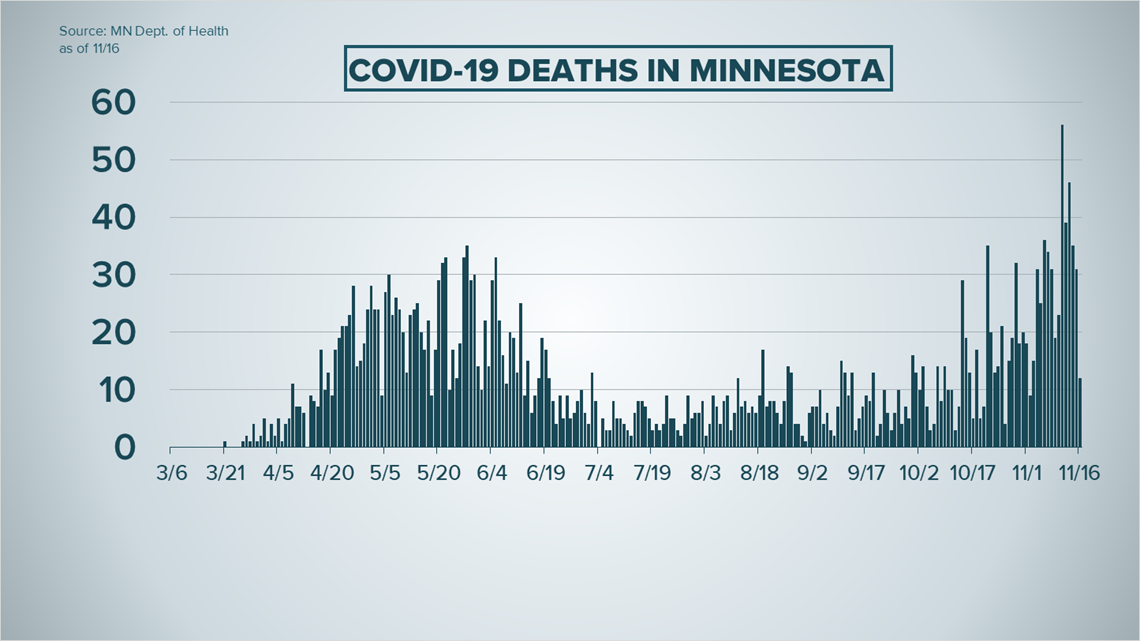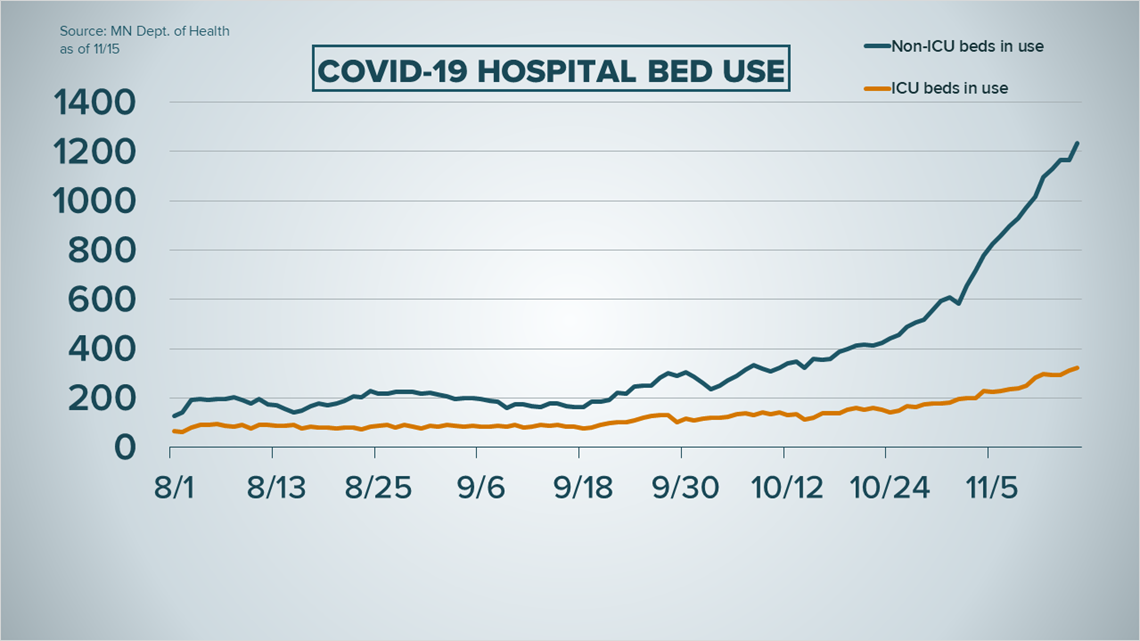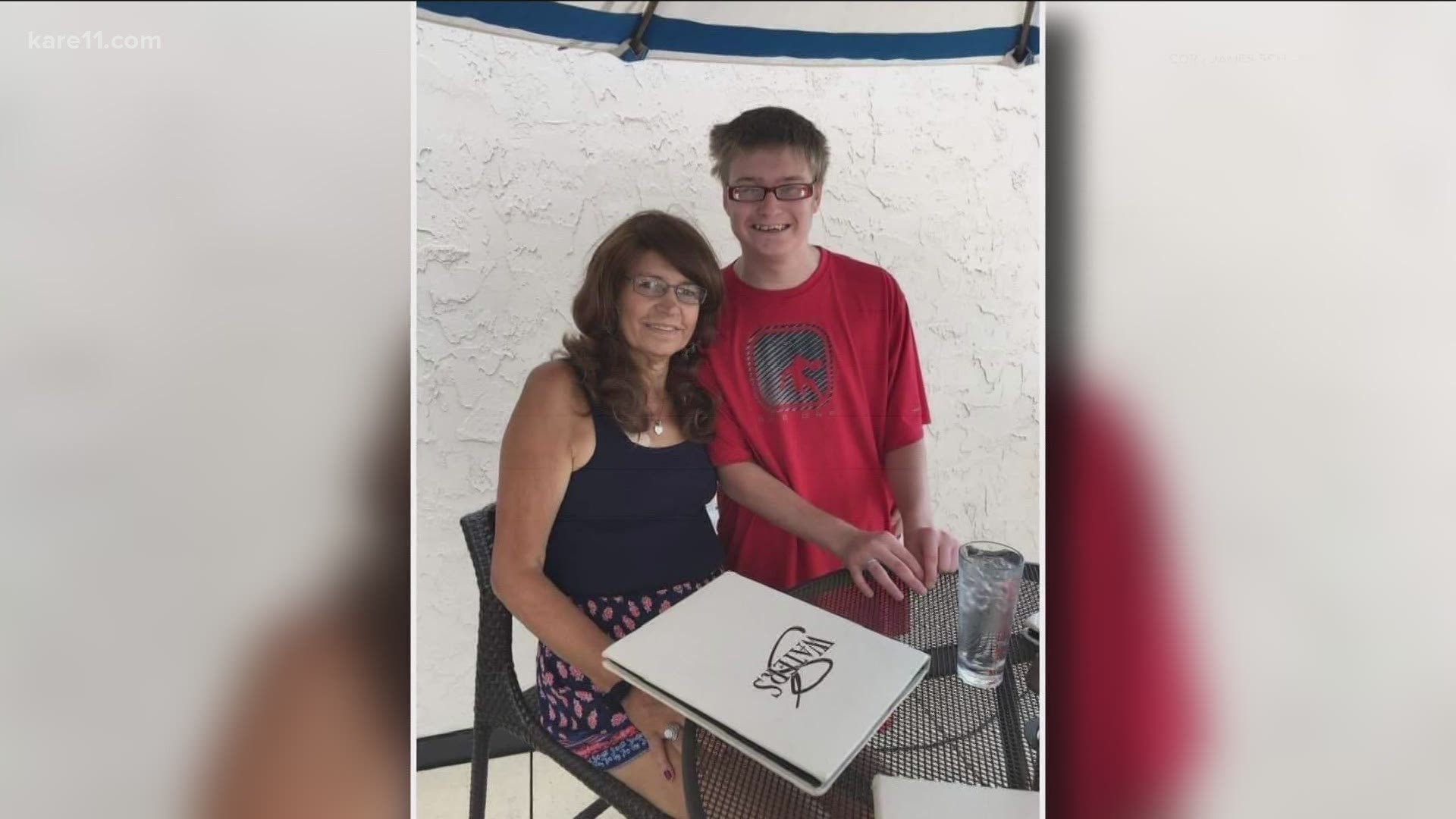ST PAUL, Minn. — Monday, Nov. 16
- Minnesota reports 3rd straight day of 7,000-plus cases
- 62 of 87 counties now under distance learning recommendations
- Second death reported in a person between ages 20-24
- Eleven new COVID-19 testing sites to open across Minnesota; mail order testing program now available statewide
2 p.m.
On Monday, Governor Tim Walz and frontline healthcare workers spoke to Minnesotans about the rapid growth of COVID-19 cases in the state.
“There’s reasons to be hopeful,” he said, referring to recent news regarding vaccines, “but I need to be very clear, we need to get all our neighbors to the end of the tunnel."
Walz went on to express that while he understands some might have concerns about decisions he's made in handling the pandemic, there is no denying that the rates of infection and death in the U.S. are worse than anywhere else in the world, and he called for political unity.
"Our greatest strength has always been here in Minnesota," he said. "We do things very, very well, and we do it because we care about our neighbors. As we enter into-- and we're there-- into the hardest and most dangerous part of the pandemic, before we get to that end of the tunnel, we're going to have to rely on one of the most basic things: we're all in this together. If we continue to mask up, social distance and take mitigation efforts, we reduce pressure on frontline health care workers."
According to MDH Commissioner Jan Malcolm, case and hospitalization numbers in Minnesota are "alarming," and she's concerned about the role the holidays might play in case growth.
"As we heard from Dr. Osterholm on Friday, 2020 is our COVID year," she said. "Right now, as we've said, things that were relatively more safe a month ago or even two weeks ago are significantly more risky now. As tempting as it is to stick with cherished traditions, we need people to reconsider and, frankly, not gather with other households, especially if those households include people in a high-risk category."
Any gathering could present a much higher risk than even a couple weeks ago, Malcolm said, and she urged Minnesotans to celebrate only with those in their immediate households.
"Any time you gather with people you don't live with, the risk of infection increases for everyone-- for you, for them and for the broader community," she said. "We know how hard this is, not to be with the people we love. And we know there will be a lot of pushback. But we believe in the next couple of weeks, we're going to tell the story of what happens in late December. We can make a difference, but we have to start right now by changing our behaviors."
Dr. Cuong Pham, assistant professor of medicine at the University of Minnesota and a physician at M Health Fairview, said that he is proud of how Minnesotans have been adapting to safe behaviors in the pandemic. But as cold weather sets in, he said Minnesota must continue those behaviors to bend the curve.
"I'm worried about our little hospitals in greater Minnesota with lesser resources," he said. "I'm worried we won't have enough beds to take care of patients without COVID. I'm worried we won't have enough of our awesome nurses and aides."
He encouraged Minnesotans to find creative ways to celebrate Thanksgiving to avoid creating more community spread across the state.
"Please, let's unite and trust each other," Dr. Pham said. "Let's keep showing the rest of the nation how Minnesotans can unite safely and still have fun."
Kelley Anaas, an intensive care nurse at Abbot Northwestern Hospital, just ended a 32-hour work weekend.
"For nurses, this pandemic has taken an emotional toll," she said. "Up until nine months ago, 'nurse' was my own professional title. Suddenly, I've earned a new title: frontline worker. Personally, I've found this laughable, because it implies there's a second line of us waiting in the wings. Minnesota: we are your only line."
Anaas said that Minnesotans need to believe nurses when they stress how urgent the situation is, and listen to what they are asking for in support. People are still getting sick and having accidents beyond COVID-19, she said, and health care workers are trying to care for all of these patients while also helping those impacted by the pandemic.
She implored people to stay home, regardless of whether or not they are displaying symptoms.
Walz emphasized that Anaas was right: there is no second line of health care workers in Minnesota.
"We need to put aside past differences, put aside debates about settled science, and buckle down to get through this thing," he said. "To take the pressure off the people who are the only ones who can take care of us."
When asked about vaccine distribution, Malcolm said that Minnesota has been led to expect three waves of vaccine availability. The first wave would start in late December or early January, and would distribute vaccines to long-term care and acute care workers. The next wave of vaccines would go to higher risk patients, and the third wave, which is not expected until spring or summer of next year, would make the vaccine available to the general population.
There have been a large number of outbreaks associated with sports in Minnesota, according to Ehresmann. Across all age groups, 35 outbreaks have been associated with football, 20 with basketball, 41 with volleyball, 15 with soccer and 46 with hockey.
Ehresmann added that MDH knows that at least 10% of all cases in schools are related to sports, and in the last week two schools transitioned to distance learning because of COVID-19 exposures from sports.
"We're looking at where the data is, and numbers are moving fairly fast," Malcolm said. "We are urging there to be a pause on play and on practice as well, from our perspective. We're in dialogue right now with our colleagues in education and the high school league, but from a health advice standpoint, we would really like to see sports put on pause."
Walz said there are a lot of people involved in that conversation, and while that possibility is being discussed, no decision has been made yet.
11 a.m.
The surge in new COVID-19 cases continues across Minnesota, with state health officials reporting the third day in a row over the 7,000 mark.
Numbers released Monday by the Minnesota Department of Health (MDH) show 7,444 people were diagnosed with coronavirus over the last 24 hours, after the department reported 7,559 on Sunday and a single-day high of 8,703 on Saturday. In total, 231,018 cases of COVID-19 have been confirmed across Minnesota since the pandemic began.
While case numbers are spiking, testing volume is also high. The new cases are based on the results of 51,207 tests processed in private and state labs (49,204 PCR tests, which are confirmed positive, and 2,003 Antigen tests, which are probable positives).
Governor Tim Walz and front line workers will speak to Minnesotans Monday at 2 p.m., urging them to follow recommended protocols and take pressure off hospitals and health care professionals who are swamped with patients. KARE 11 will carry the press conference live on kare11.com and YouTube.
Another 12 Minnesotans died from the virus in the past day, bringing the total of fatalities to 2,917. Of those deaths 2,003, or 69% of them, are linked to long-term care or assisted living settings.


Total hospitalizations have climbed to 13,251 since the pandemic hit Minnesota, with 3,203 of those patients requiring care in the ICU. On Monday MDH reported that 1,558 hospital beds were in use by COVID-19 patients, a new single-day high. Of those beds, 324 of them are in intensive care.


MDH says 179,614 people who once tested positive for coronavirus have recovered to the point they no longer require isolation.
People ages 20 to 24 make up the largest grouping of COVID cases with 26,743 and two deaths, followed by those 25 to 29 with 22,012 cases and three deaths. Those between 30 and 34 account for 19,930 and nine fatalities.
The largest group of deaths involves Minnesotans between 85 and 89, with 534 deaths in just 2,893 cases.
Hennepin County health officials report the most COVID activity with 51,712 cases and 1,050 fatalities, followed by Ramsey County with 21,659 cases and 433 deaths. Anoka County reports 16,571 cases and 190 deaths.
Cook County in the northeastern part of the state continues to report the least amount of COVID activity with 44 cases and zero fatalities, followed by Lake of the Woods County with 76 cases and one death.
Sunday, Nov. 15
2 p.m.
The Wisconsin's Department of Health Services (WDHS) reported 6,058 new cases on Sunday, bringing the total number of confirmed cases statewide to 312,369.
Health officials reported 12 more deaths Sunday as the total number of fatalities statewide climbs to 2,637. The total number of fatalities is approximately 0.8% of those testing positive for the virus.
Due to high case numbers, Gov. Tony Evers issued an emergency order mandating indoor face coverings that began at 12:01 a.m. Saturday, Aug. 1. On Tuesday, Sept. 22, Evers extended the mask mandate until Nov. 21.
On Tuesday, Oct. 6 Gov. Evers' administration issued a new order limiting the size of public indoor gatherings to 25% of capacity, to stem the spread of COVID-19. That order was struck down on Oct. 13 by a judge in Sawyer County. The order was reinstated on Oct. 19 by a Barron County judge, but on Oct. 23, a Wisconsin appeals court put a hold on the order.
Wisconsin health officials say a total of 14,381 people have been hospitalized from the coronavirus since the start of the pandemic, about 4.6% of the total number of people who have been diagnosed with the virus.
Of the confirmed cases in Wisconsin, 21% involve people between the ages of 20 to 29, 16% are between 30 and 39, 15% are between 50 and 59, and 14% are 40 to 49. An estimated 11% are between 10 and 19, and another 11% are between 60 and 69.
As of Sunday, Milwaukee County reported the largest number of confirmed cases with 55,918, along with 643 deaths. Dane County has reported 21,720 confirmed cases and 61 deaths, and Brown County has 19,843 cases and 121 deaths.
A more detailed breakdown of cases by county can be found on the DHS website.
11 a.m.
The Minnesota Department of Health (MDH) reported 7,559 new COVID-19 cases Sunday, along with 31 new deaths.
MDH's COVID-19 case definition was recently updated to include antigen testing. Previously, cases were only reported through polymerase chain reaction (PCR) testing. Positive PCR test results are considered confirmed cases, while positive antigen test results are considered probable cases.
MDH will combine these totals for its death, hospitalization and demographic reporting. The department will report the numbers separately for some other areas, like newly reported cases and total cases by county of residence.
Sunday's new case total includes 7,383 confirmed cases and 176 probable cases.
The total number of Minnesotans who have tested positive for the virus since the pandemic began is now 223,581 and 2,621 of them were antigen test results.
MDH says 31 new deaths from the virus were reported in the past day. This pushes the total number of fatalities in Minnesota to 2,905.
To date, 13,074 Minnesotans have been hospitalized with the coronavirus since the pandemic started, with 3,176 of them needing care in the ICU.
MDH reports that 172,873 people once diagnosed with the virus have recovered enough that they no longer need isolation.
Of those who have tested positive, people between the ages of 20-24 account for the most cases with 26,058 cases and two deaths, and ages 25-29 follow with
21,368 cases and three deaths. Those between 85 and 89 years old account for the highest number of fatalities in one age group with 533, out of 2,814 cases.
In terms of likely exposure to the coronavirus, MDH says 45,566 cases were the result of community transmission with no known contact with an infected person, and 40,227 had known contact with a person who has a confirmed case.
A total of 19,196 cases involved exposure in a congregate living setting, 4,297 were in a corrections setting, and 470 were in a homeless shelter. MDH data shows 11,851 were linked to an outbreak outside of congregate living or health care.
MDH says 16,071 cases were linked to travel. Health care workers or patients account for 6,132 of diagnosed COVID-19 cases. The source of transmission for 79,771 cases is still unknown or missing.
MDH has prioritized testing for people in congregate care, hospitalized patients and health care workers, which may impact the scale of those numbers. However, now MDH is urging anyone who is symptomatic or even asymptomatic to be tested. Testing locations can be found online.
Hennepin County has the most cases in the state at 49,955 confirmed cases with 1,044 deaths, followed by Ramsey County with 20,788 cases and 430 deaths. Anoka County reports 15,460 cases and 189 deaths.
Full data, including a breakdown of PCR and antigen test totals in some categories, can be found on MDH's website.

